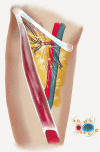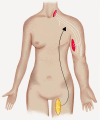Lymphatic mapping and lymphedema surgery in the breast cancer patient
- PMID: 26161309
- PMCID: PMC4461704
- DOI: 10.3978/j.issn.2227-684X.2015.03.02
Lymphatic mapping and lymphedema surgery in the breast cancer patient
Abstract
Upper limb lymphedema can be an unfortunate sequela following the oncologic treatment of breast cancer. The surgical treatment of lymphedema has had a recent renewed clinical interest paralleling innovative descriptions of surgical techniques and imaging modalities. In addition, an improved understanding of the physiology and pathophysiology of lymphedema has allowed improved translation to the clinical condition. Various surgical options exist to decrease the symptom-burden of upper limb lymphedema, including vascularized lymph node (VLN) transfer, lymphovenous bypass (LVB), liposuction, lymphatic grafting, and excisional procedures. Modern imaging techniques help to improve the consistency and accuracy of these surgical treatment options. A multi-modal treatment plan utilizing non-operative and surgical therapies has the potential to improve various factors related to overall patient quality of life. This review details all of the current operative treatment strategies and modern imaging modalities used in the treatment of lymphedema.
Keywords: Lymphatic mapping; liposuction; lymphatic grafting; lymphatic surgery; lymphedema; lymphovenous bypass (LVB); microsurgery; vascularized lymph node (VLN) transfer.
Figures







References
-
- Warren AG, Brorson H, Borud LJ, et al. Lymphedema: a comprehensive review. Ann Plast Surg 2007;59:464-72. - PubMed
-
- Wilke LG, McCall LM, Posther KE, et al. Surgical complications associated with sentinel lymph node biopsy: results from a prospective international cooperative group trial. Ann Surg Oncol 2006;13:491-500. - PubMed
-
- Nesvold IL, Dahl AA, Løkkevik E, et al. Arm and shoulder morbidity in breast cancer patients after breast-conserving therapy versus mastectomy. Acta Oncol 2008;47:835-42. - PubMed
Publication types
LinkOut - more resources
Full Text Sources
